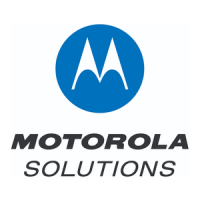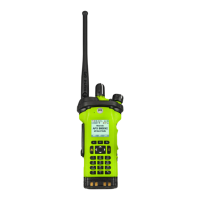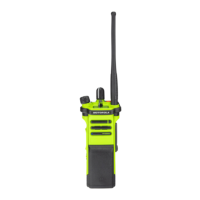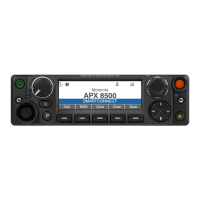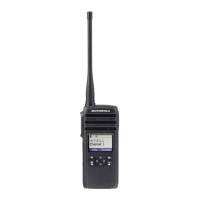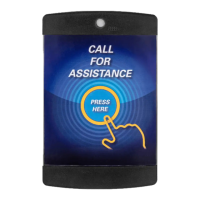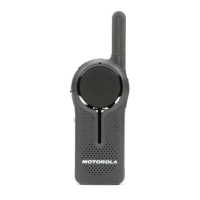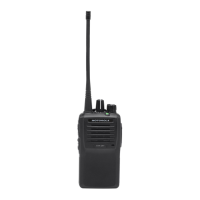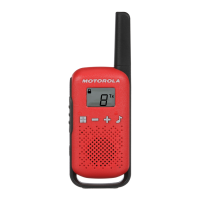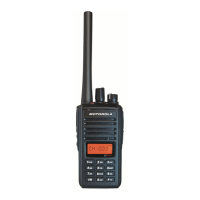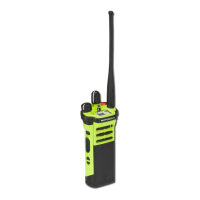
Do you have a question about the Motorola solutions APX 6000XE and is the answer not in the manual?
| Channel Capacity | 1000 Channels |
|---|---|
| Operating Temperature | -30°C to +60°C |
| GPS | Yes |
| Bluetooth | Yes |
| Type | Digital Two-Way Radio |
| Frequency Range | 700/800 MHz |
| Water Resistance | IP68 |
| Encryption | AES-256 |
| Intrinsic Safety | Yes |
| Display | Color |
Explains special notations like Warning, Caution, and Notice used to emphasize safety hazards and procedures.
Covers cleaning, service, and repair procedures for optimal radio operation and longevity, including vent port care.
Provides information on participating in the Call2Recycle program for battery collection and recycling.
Suggests consulting your dealer or system administrator for radio settings, programmed features, and accessories.
Instructions for charging the radio's battery, including safety warnings and charging time recommendations.
Procedure for attaching and removing the battery from the radio, including notes on IMPRES battery status.
Step-by-step guide on how to properly attach and remove the antenna from the radio.
Details on how to power on the radio using the On/Off/Volume Control Knob.
Instructions on how to increase or decrease the radio's volume using the control knob.
Overview of the radio's physical components and controls, with numbered diagrams for identification.
Explains assignable functions and settings for radio buttons and switches, including call features and system functions.
Details on how the radio indicates battery level via LED, sounds, and icons, including fuel gauge and HAZLOC detection.
Explanation of the different LED color and blinking patterns indicating radio operational status.
Description of various icons displayed on the LCD indicating radio status, signal strength, and connectivity.
List of alert tones and the conditions under which they are heard, informing the user of radio status.
Instructions on how to select a zone, which is a group of channels, using switches or menu options.
Guide on selecting a radio channel, which includes transmit/receive frequency pairs and parameters.
Explains how to save the current zone and channel to a softkey or button for quick access.
Covers receiving and responding to talkgroup, private, and telephone calls based on system indicators.
Details on initiating different types of radio calls using zones, channels, subscriber IDs, or contacts.
Explains how to monitor a channel or conventional mode to check for clear transmission before sending.
Describes optimization for message sizes and variable update rates for improved data channel efficiency.
Feature that prevents crosstalk scenarios by adjusting internal SSI clock rate to reduce interference.
Enables secured communications on Analog or MDC channels, including Over-the-Air Rekeying (OTAR).
Provides low-cost portable radio coverage in areas where only mobile coverage is available.
Improves Scan feature operation for conventional talkgroups, supporting Selective Squelch.
Virtual assistant for managing radio and performing information lookups using voice commands.
Details on selective calls, talkgroup calls, status calls, and priority dispatch calls for enhanced communication.
Covers emergency modes like alarm, call, and silent alarm, with special considerations for operation.
Safety feature that detects user inactivity or falls, triggering alerts and potentially emergency functions.
Enables sending and receiving text messages, including quick text, priority status, and request reply.
Covers selecting secure or clear transmissions and managing encryption keys for secure communication.
Features for determining radio location using GPS, including formats, saving waypoints, and emergency mode.
Information on FCC certified accessories, compatibility, and supported devices like PSM and GPS antennas.
Statement regarding the reliability of information and Motorola Solutions' disclaimer of liability.
Product conforms to FCC Part 15 regulations for Class B Digital Devices.
RF Energy Exposure and Product Safety Guide, including cautions for occupational use and antenna selection.
FCC rules regarding device interference, acceptance of received interference, and user modifications.
Covers emergency and non-commercial channels for maritime communication, including distress call procedures.
Details FCC requirements for shipboard radio operation on specific VHF frequencies.
Specifies the warranty period for portable units and accessories, and Motorola Solutions' repair options.
Outlines the exclusive remedy, limitations on implied warranties, and liability for damages.
Lists exclusions from warranty coverage, including misuse, accident, unauthorized modifications, and cosmetic damage.
Details Motorola Solutions' defense against patent infringement claims and exclusive rights for software.
Acknowledgment of communication.
Motorola Solutions standard for wireless digital trunked communications.
Open wireless technology standard for exchanging data over short distances with high security.
Feature indicating a critical situation, overriding other communication and supporting emergency modes.
Provides high-level voice security on trunked and conventional channels with automatic encrypted environments.
Automatic sharing of communication paths among users, assigning paths to talkgroups for conversation duration.

